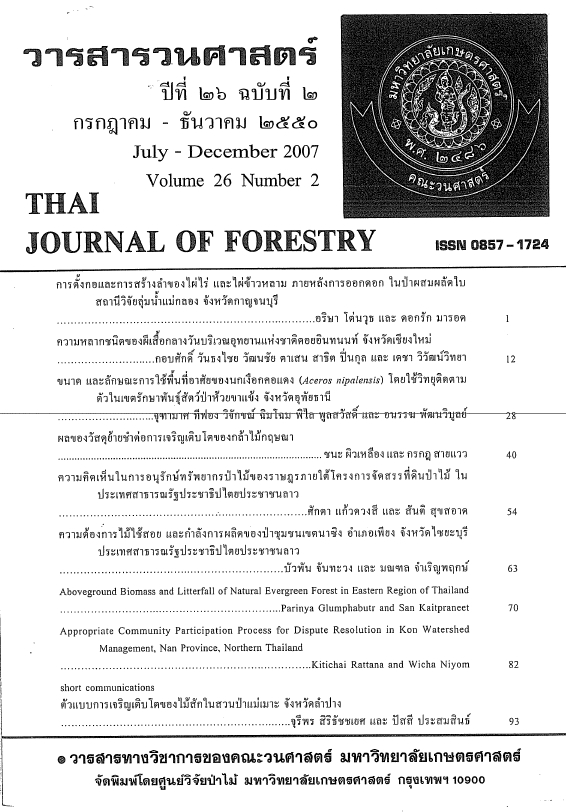ขนาด และลักษณะการใช้พื้นที่อาศัยของนกเงือกคอแดง (Aceros nipalensis) โดยใช้วิทยุติดตามตัว ในเขตรักษาพันธุ์สัตว์ป่าห้วยขาแข้ง จังหวัดอุทัยธานี
Main Article Content
บทคัดย่อ
การศึกษาวิจัยมีวัตถุประสงค์หลักคือ ประเมินขนาดพื้นที่อาศัย และพื้นที่อาศัยที่เหมาะสมของนกเงือกคอแดงโดยการใช้วิทยุติดตามตัวในพื้นที่ป่าดิบเขา เขตรักษาพันธุ์สัตว์ป่าห้วยขาแข้ง ทำการเก็บข้อมูลในระหว่างเดือนพฤษภาคม 2547 ถึงเดือนพฤษภาคม 2550 และได้มีการศึกษาเปรียบเทียบขนาดพื้นที่อาศัยของนกเงือกคอแดงระหว่างฤดูผสมพันธุ์ และนอกฤดูผสมพันธุ์ และระหว่างนกเงือกคอแดงแต่ละตัว จากการศึกษาพบว่า นกเงือกคอแดงถูกจับเพื่อติดวิทยุจำนวนรวม 3 ตัว จาก 2 รัง ขนาดพื้นที่อาศัยของนกเงือกคอแดงรวมทั้ง 3 ตัว เท่ากับ 25.86 ± S.D. 1.32 ตารางกิโลเมตร นกเงือกคอแดงตัวผู้และตัวเมียรังแรกมีขนาดพื้นที่อาศัยตลอดปีเท่ากับ 11.24 ± S.D. 1.19 และ 10.96 ± S.D. 1.04 ตารางกิโลเมตร ตามลำดับ สำหรับนกเงือกคอแดงตัวผู้รังที่ 2 มีขนาดพื้นที่อาศัยตลอดปีเท่ากับ 23.84 ± S.D. 2.14 ตารางกิโลเมตร จากผลการศึกษาจะเห็นได้ว่าฤดูกาลมีผลต่อขนาดพื้นที่อาศัย โดยนอกฤดูผสมพันธุ์มีการใช้พื้นที่ขนาดกว้างใหญ่กว่าฤดูผสมพันธุ์ และขนาดพื้นที่ของตัวผู้มีขนาดกว้างใหญ่กว่าตัวเมียทั้ง 2 ฤดูกาล จากการวิเคราะห์ทางสถิติขนาดพื้นที่อาศัยของนกเงือกคอแดงระหว่างฤดูกาลมีความแตกต่างกัน (P = 0.015, Z = -2.439) แต่ไม่มีความแตกต่างกันระหว่างตัวผู้และตัวเมีย (P = 0.648, Z = -0.456) และระหว่างตัวผู้ด้วยกัน (P = 0.770, Z = -0.293) พื้นที่อาศัยที่เหมาะสมต่อการอยู่อาศัยของนกเงือกคอแดงประกอบด้วย 4 ปัจจัย คือ ความสูงจากระดับน้ำทะเล ความลาดชัน ชนิดป่าและระยะทางจากแหล่งน้ำ โดยมีขนาดพื้นที่อาศัยเหมาะสมมาก, ปานกลาง, น้อย และน้อยมากหรือไม่พบเท่ากับ 8.58, 10.71, 16.86 และ 65.58 ตารางกิโลเมตร ตามลำดับ จากพื้นที่ศึกษาทั้งหมด 101.73 ตารางกิโลเมตร จากการศึกษาแบบจำลองพื้นที่อาศัยที่เหมาะสมต่อการอยู่อาศัยของนกเงือกคอแดงสามารถนำไปสู่การจัดการพื้นที่ป่าดิบเขาในเขตรักษาพันธุ์สัตว์ป่าห้วยขาแข้งเพื่อการอนุรักษ์นกเงือกคอแดง และนกเงือกชนิดอื่นๆ ต่อไป
คำสำคัญ: นกเงือก วิทยุติดตามตัว พื้นที่อาศัย พื้นที่อาศัยที่เหมาะสม
Downloads
Article Details

อนุญาตภายใต้เงื่อนไข Creative Commons Attribution-NonCommercial-NoDerivatives 4.0 International License.
ข้าพเจ้าและผู้เขียนร่วม (ถ้ามี) ขอรับรองว่า ต้นฉบับที่เสนอมานี้ยังไม่เคยได้รับการตีพิมพ์และไม่ได้อยู่ในระหว่างกระบวนการพิจารณาตีพิมพ์ลงในวารสารหรือสิ่งตีพิมพ์อื่นใด ข้าพเจ้าและผู้เขียนร่วม (ถ้ามี) ยอมรับหลักเกณฑ์และเงื่อนไขการพิจารณาต้นฉบับ ทั้งยินยอมให้กองบรรณาธิการมีสิทธิ์พิจารณาและตรวจแก้ต้นฉบับได้ตามที่เห็นสมควร พร้อมนี้ขอมอบลิขสิทธิ์ผลงานที่ได้รับการตีพิมพ์ให้แก่วารสารวนศาสตร์ คณะวนศาสตร์ มหาวิทยาลัยเกษตรศาสตร์ กรณีมีการฟ้องร้องเรื่องการละเมิดลิขสิทธิ์เกี่ยวกับภาพ กราฟ ข้อความส่วนใดส่วนหนึ่ง หรือ ข้อคิดเห็นที่ปรากฏในผลงาน ให้เป็นความรับผิดชอบของข้าพเจ้าและผู้เขียนร่วม (ถ้ามี) แต่เพียงฝ่ายเดียว และหากข้าพเจ้าและผู้เขียนร่วม (ถ้ามี) ประสงค์ถอนบทความในระหว่างกระบวนการพิจารณาของทางวารสาร ข้าพเจ้าและผู้เขียนร่วม (ถ้ามี) ยินดีรับผิดชอบค่าใช้จ่ายทั้งหมดที่เกิดขึ้นในกระบวนการพิจารณาบทความนั้น”


